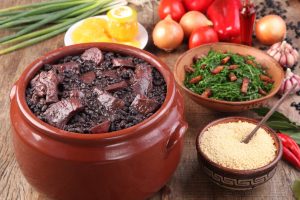By Lindenberg Junior | English edition/review by Ann Fain
 The Brazilian cuisine has been strongly influenced by Portuguese colonization, the African roots brought by the slaves during the eighteen century, as well the Italian, German, Syrian and Lebanese immigrants, who came at the end of the nineteenth century. Brazilian culinary build into a rich variety of flavors and colors adapted to local ingredients, which is unique, delicious and sometimes exotic. Each region has its specialties, as Brazil is so vast.
The Brazilian cuisine has been strongly influenced by Portuguese colonization, the African roots brought by the slaves during the eighteen century, as well the Italian, German, Syrian and Lebanese immigrants, who came at the end of the nineteenth century. Brazilian culinary build into a rich variety of flavors and colors adapted to local ingredients, which is unique, delicious and sometimes exotic. Each region has its specialties, as Brazil is so vast.
In the Northeast, especially in Bahia, African influence is prominent with the spiciest food such as Acarajé (a mashed bean small cake stuffed with peppers, dried shrimp, onions and ginger), Vatapá (a puree of fish or shrimp) and Moqueca (seafood broth eaten with rice). The Amazon is better known for the Indian influence and has a diet rich of fish (Pirarucu), root vegetables, yams, yucca or tropical fruits. Sao Paulo and Rio de Janeiro, the two most cosmopolitan cities of Brazil, there is a great concentration of national and international restaurants with contemporary food. Minas Gerais, the state North of Rio and SP, is knowing all over Brazil for the famous “pão de queijo” (cheese bread).
The Churrasco or Brazilian B.B.Q is a contribution from the South, it is among Brazilian favorites and widely found in the steakhouses all over the country – and in the last decade, all over the world. In this “All You Can Eat” steakhouses (or in Portuguese, churrascarias), pieces of beef, chicken, pork and lamb of all types is marinated in rock salt (only), skewered into a metal sword and roasted over hot coals.
 But, the most traditional Brazilian dish/recipe is Feijoada a heritage from African slaves during Brazil’s colonization. They used pork leftovers that their Portuguese masters would not eat, such as ears and tail cooked with black beans, cumin and laurel.
But, the most traditional Brazilian dish/recipe is Feijoada a heritage from African slaves during Brazil’s colonization. They used pork leftovers that their Portuguese masters would not eat, such as ears and tail cooked with black beans, cumin and laurel.
Nowadays it is made with many different smoked and sun dried meats, served with a number of side dishes including sliced oranges, farofa (stir-fried manioc flour), couve mineira (thinly sliced kale in garlic/oil) and white rice, and usually served on Wednesdays and Saturdays. Savory snacks served as appetizers called “salgadinhos” are not to miss: codfish croquettes, rice cake, manioc cake stuffed with dry beef or melt fresh cheese and pao de queijo (small hot cheese rolls).
Delicious tropical fruits is found all year round. Some rare examples are açaí, cajú, cupuaçu, graviola, mangostim, carambola, pitanga, romã, cajá, umbú, tamarindo, saputi, jaboticaba, acerola, mangaba, among others.Among the popular drinks are chopp (draft beer) and the Brazilian’s favorite, caipirinha (made by cachaça, alcoholic beverage distilled from sugar cane). Guaraná is the traditional Brazilian soda made by the energetic Amazon berry called also guaraná. Brazilians are also proud of their national coffee, ranking as one the largest producers in the world.
